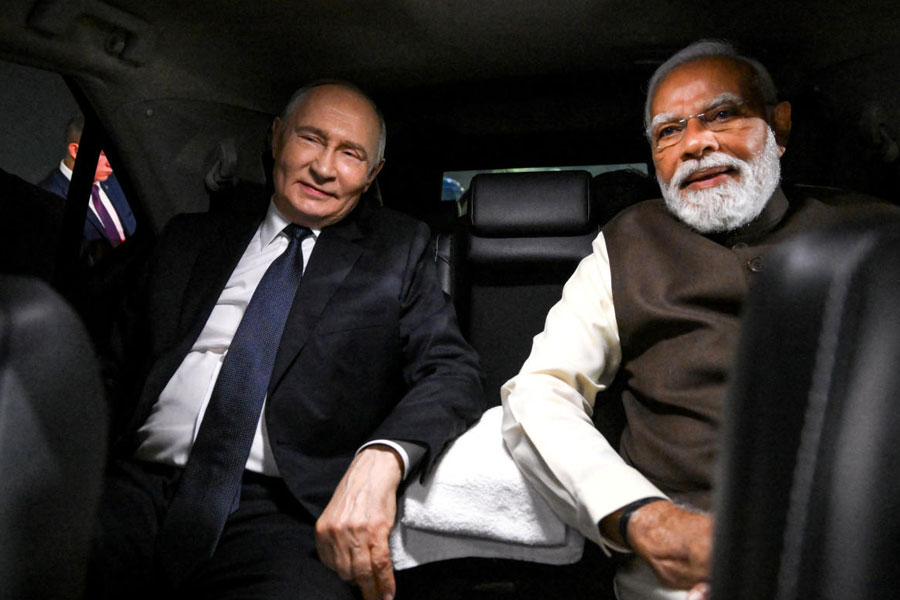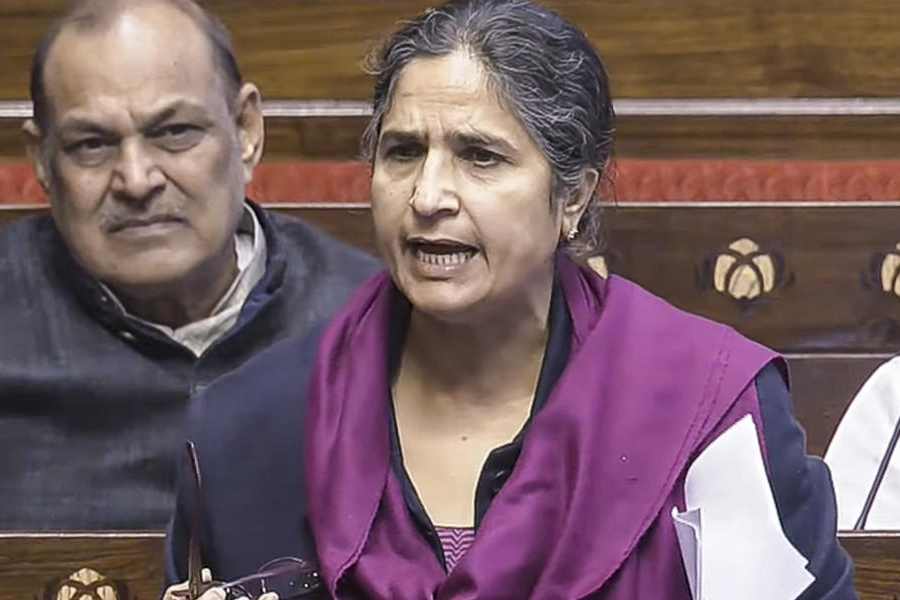 |
| A family in Patna heads to the Ganga to offer the evening puja on Friday. Picture by Jai Prakash |
Chhath ke argha taa deyli babua,
Tabhiyo Bihar naa sudhri…
(I’ve done the devotionals of Chhath, young one,
But even so Bihar shan’t redeem itself)
— play on the refrain of a popular, self-deprecating Bhojpuri ballad
For far too long, Bihar’s name was, in good measure, infamy. It exported hungry migrants, bad news and an outcrop of civil servants. The first two did Bihar little credit. The third came at such a premium it became not a Bihari thing but exceptional of Bihar — they were uber-Biharis, those that had overcome Bihar rather than come off it. Bihar: boondocks of malignant cargo.
That unseemly signature has begun to cure itself lately, and may already have become a stylised curl along fringes of water across the land. From the Juhu beachfront in Mumbai to the Ganga ghats of Varanasi and Calcutta, to the shallow moats of Delhi’s Boat Club and punctuations of rivulet, stream and pond strewn betwixt, an iridescent frill has erupted and put new colour and contour to what Bihar or Bihari might mean — pre-Vedic Chhath has brought to its devotees the gift of a post-modern consciousness, the opening of a grand frontier of their mostly hard-pressed migration.
It’s what N.K. Singh, technocrat, politician and notarised fellow of Bihar’s ruling elite, calls a “cultural watershed” in the annals of his people. “The journey of Chhath out of Bihar and to far places is, finally, evidence of the confident assertion of Bihari identity,” he says. “It represents a phenomenon far beyond migration, this is high-value migration. Like Diwali has travelled to the White House, Chhath has taken other parts of India in its sweep.” What Singh picks out as most remarkable is that “Chhath is not something Biharis are sheepish any more to observe outside their domain, they are doing it with pride wherever they are”.
The just-concluded annual assignation is no more some obscurantist rummage that Bihar’s milling underclasses quietly get over with; it has become a vibrant sub-national fiesta whose echo is ringing from corporate boardrooms to high society parlour rooms to starchy white collar corridors.
Biharis — and their brethren and co-celebrants in Jharkhand — fill in many more home-leave applications for Chhath than for Diwali. During the three days preceding the commencement of festivities, the footfall at New Delhi railway station burgeoned over three times to 36 lakh people, the majority of them Bihar-bound on regular or special trains. Suman Sinha, the vice-president of a Mumbai firm, says there can be no compromising on Chhath: “I have been going home to Patna for Chhath for the past 10 years. I apply for leave two months ahead. I take pride in telling my Mumbai colleagues about the rituals we perform.”
There might be good reasons churning this rediscovery, some conscious, some subliminal. The week post-Diwali each year — the first days of the lunar month of Kartik, of which the sixth, or chhathi, marks Chhath — spurs the sense among Biharis that their thing of pride isn’t only remote or historic, it need not merely be the frozen textbook legacy of Buddha and Mahavir, Chanakya and Chandragupta Maurya and Asoka. It is equally what they give unto themselves each year, an extant and organic force-of-nature practice that touches off the sublime in what may seem only mundane — the unceasing flow of the great river, the undying cycle of the Sun, and looped between them, the eternal circle of life itself.
Attached to Chhath too are temporal values that belie stereotypes that often tarnish Bihar; it eschews the effete. It is not a caste-ridden enterprise, as too many others in Bihar can be. Dalit and Bhumihar, Yadav and Brahmin descend alongside into the waters at Chhath, and lift an offering to the skies. It can, if only for part of a week, smother Manuwadi discriminations. Chhath is not sectarian either; Muslims in parts of Bihar are known to have joined in and made Chhath a people’s tableau; there’s no idol worship involved, only an invocation of nature and its elements.
As Pavan Varma, former diplomat and now culture adviser to Bihar chief minister Nitish Kumar, puts it: “The salient feature of Chhath is that it unites a people across categories, and brings Biharis into a oneness. That Chhath has become celebrated beyond Bihar is symbolic of the new Bihar itself, its new confidence in itself. Chhath has become almost an exemplar of rooted Indian celebrations.”
It is probably simplistic to reduce the observation of Chhath to Sun worship; the Hindu cult is broader, and often more complicated, than the prescriptions of Hindu religion. Stripped of Brahmanic and consumerist embellishment, Chhath is an animist validation of life that pre-dates the scriptures — water offered in thanksgiving to the Sun, preserver of life given over to life’s progenitor. It cannot be Chhath is not a fertility ritual as well, not with the Sun involved. We have all been told what happened when Kunti went prostrating herself before Surya; Karna came as consequence. “The beauty of Chhath lies in the utter simplicity of its reason,” says Prabha Chaudhary, a biology teacher from Patna who has performed the rites for more than 40 years. “It is that we live and we thank what makes life possible.”
And yet, Biharis may have surprised themselves with the expanding constituency of Chhath’s embrace. In Mumbai, it has trampled over parochial naysayers of the Sena and swelled its ranks year after year. “Earlier, about two lakh people would come to Juhu beach because Chhath was opposed by some political parties,” says BJP leader Amarjit Mishra, shy to name his Sena allies as culprits. “But this year about five to six lakh people have performed rites.” Among them, not merely the denigrated “bhaiyyas” from Bihar and Uttar Pradesh, but a fair sprinkling of Marathi speakers too.
In Calcutta, Chhath has earned endorsement from Bengal chief minister Mamata Banerjee’s office. A restricted, or “sectional”, holiday for staff, elaborate bandobast along the ghats overseen personally by Mamata, a notice on the chief minister’s Facebook page and a message of felicitation for “all my Bihari bothers and sisters”. A senior officer at Lalbazar — the headquarters of the Calcutta Police — set out Chhath’s new status thus: “I do not remember any Bengal chief minister visiting ghats to oversee preparations. The moment the chief minister becomes so involved, the festival automatically attracts attention, both in terms of security arrangements and publicity.”
In Delhi, Chhath broke through barriers that have long remained shut to the capital’s high and mighty — the Boat Club along the central vista of Raj Path. For close to two decades now, the lawns have been off limits for large gatherings; Chhath made an exception. It could well be that impending Assembly elections nudged the government to opening the Boat Club pools in addition to 72 ghats along the Yamuna, but a precedent has now been created for Biharis to insist on in future years.
Chhath is going places, more places than could fit your reckoning. Look at the picture from a greater remove, look at the globe as a Google map would represent it. Look at how wide the empire of Chhath lays itself — from the Atlantic waterfronts of Guyana and Suriname to the far Pacific isles of Fiji via Mauritius in the Indian Ocean. And it isn’t as if its conquests at home have ceased.
Delhi University social scientist and spokesperson for Lalu Prasad’s RJD, Manoj Jha, speaks of Chhath as a “sensibility creeping closer” by the year. “My family has no history of celebrating Chhath, but for some reason, I can feel it is beginning to overwhelm us,” Jha admits. “Not in any religious sense but as a cultural identifier and binder. If you are Bihari, Chhath must be part of your calendar and your discourse.”
STAR India CEO Uday Shankar believes Chhath is more a symbol of cultural identity. “It is a phase of sub-cultural resurgence all across India. Bihar is not untouched by it. In that sense, Chhath has emerged as a festival symbolising the sub-cultural resurgence.”
In sheer numbers of devotees, Sachin Tendulkar may well have outdone the Sun this Chhath week. But come the next, Sachin will trail into the sunset; the Sun will lift itself again on the dark horizon and urge another Bihari to renew the vows of newfound pride.
pre-vedic validation of life
What is Chhath?
A festival preceding the Vedas. The Srimad Devi Bhagwat Purana, written between the 10th and 13th centuries AD, says the devotees worshipped the Sun god and Shashthika — a form of Durga considered the protector of children and those still in the womb
Any other references?
The Mahabharat says Draupadi observed Chhath, which helped the Pandavas regain their
kingdom. Some believe that Karna, son of the Sun god, who ruled Anga Pradesh (Bhagalpur) too performed Chhath
How is Chhath observed?
It involves four days of rituals and long fasts. The main offering is made on the third day to the setting Sun. The fourth day begins with an offering to the rising Sun. Priests have no role











